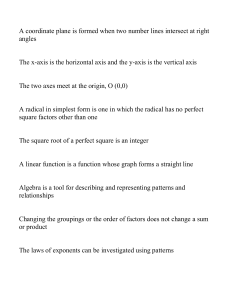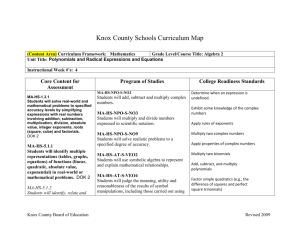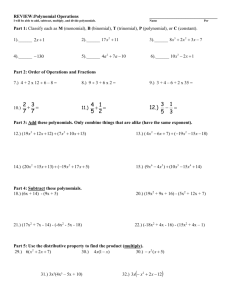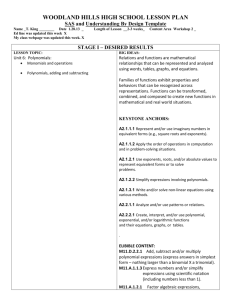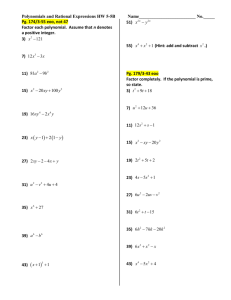095 sample syllabus - Quinsigamond Community College
advertisement
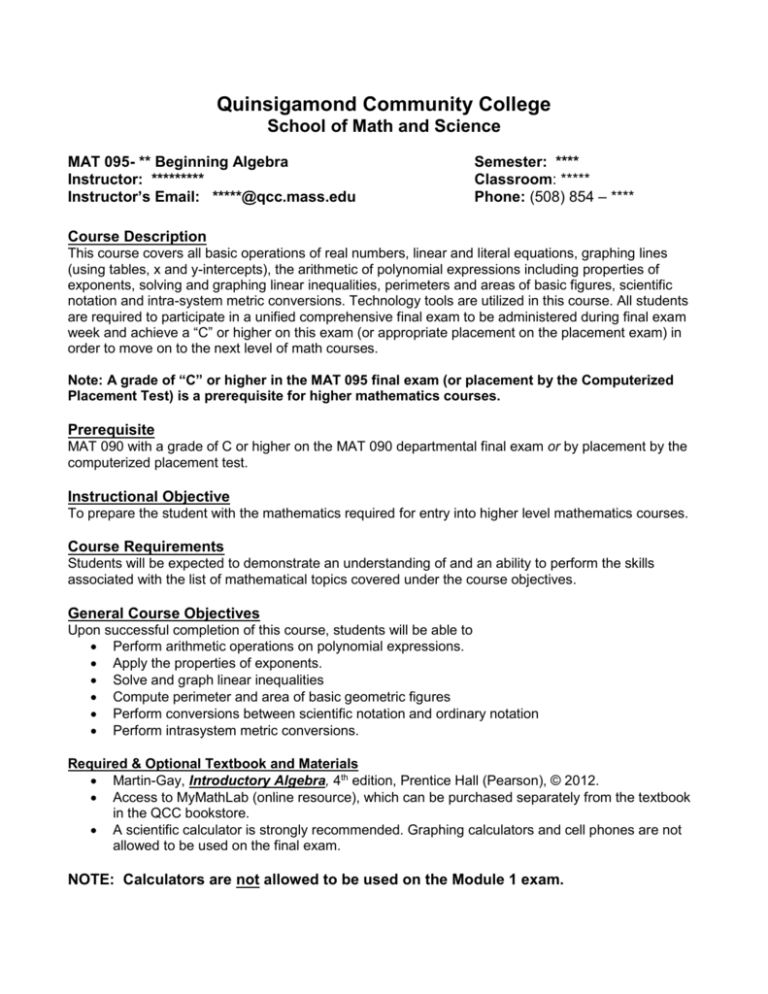
Quinsigamond Community College School of Math and Science MAT 095- ** Beginning Algebra Instructor: ********* Instructor’s Email: *****@qcc.mass.edu Semester: **** Classroom: ***** Phone: (508) 854 – **** Course Description This course covers all basic operations of real numbers, linear and literal equations, graphing lines (using tables, x and y-intercepts), the arithmetic of polynomial expressions including properties of exponents, solving and graphing linear inequalities, perimeters and areas of basic figures, scientific notation and intra-system metric conversions. Technology tools are utilized in this course. All students are required to participate in a unified comprehensive final exam to be administered during final exam week and achieve a “C” or higher on this exam (or appropriate placement on the placement exam) in order to move on to the next level of math courses. Note: A grade of “C” or higher in the MAT 095 final exam (or placement by the Computerized Placement Test) is a prerequisite for higher mathematics courses. Prerequisite MAT 090 with a grade of C or higher on the MAT 090 departmental final exam or by placement by the computerized placement test. Instructional Objective To prepare the student with the mathematics required for entry into higher level mathematics courses. Course Requirements Students will be expected to demonstrate an understanding of and an ability to perform the skills associated with the list of mathematical topics covered under the course objectives. General Course Objectives Upon successful completion of this course, students will be able to Perform arithmetic operations on polynomial expressions. Apply the properties of exponents. Solve and graph linear inequalities Compute perimeter and area of basic geometric figures Perform conversions between scientific notation and ordinary notation Perform intrasystem metric conversions. Required & Optional Textbook and Materials Martin-Gay, Introductory Algebra, 4th edition, Prentice Hall (Pearson), © 2012. Access to MyMathLab (online resource), which can be purchased separately from the textbook in the QCC bookstore. A scientific calculator is strongly recommended. Graphing calculators and cell phones are not allowed to be used on the final exam. NOTE: Calculators are not allowed to be used on the Module 1 exam. Student Resources The Math Center provides free, drop-in tutorial assistance for students in any QCC mathematics course. Located on the second floor of The Learning Center, the Math Center is a welcoming place where students have the opportunity to work intensively to improve their mathematical skills or simply drop by to ask a few questions. The Center’s hours for this semester are concurrent with The Learning Center’s hours; call 854-7487 for more information. In addition to providing tutoring, the Center houses student math resources such as the students’ and instructor’s solutions manuals to your text, computers for MyMathLab access and use, and additional textbooks. There are several math tutorial software titles on the Center’s computers that are very useful if you need to review a topic or need alternative explanations for material presented in class. Check the QCC Math Center website, http://www.qcc.edu/services/math-center. MyMathLab.com is an ancillary student support package. This website provides students with an interactive textbook, sample problems, video lectures, and online tutors. See your instructor for his/her Course ID code so you may register and utilize the wealth of resources to be found at this site. Methods of Instruction The classes will be a combination of mini-lectures, discussions, group work, and writing activities. Attendance Most students find it difficult to learn Mathematics on their own and, since this is a rigorous course, it is expected that you will attend all classes for the full period in order to be successful in this course. Should you happen to miss a class, you will be responsible for making up that day’s work and getting notes from another student or feel free to contact your instructor. Missed exam policy: **** Missed quiz policy: **** Attendance policy: **** Student Responsibilities It is expected that every student will work two hours outside of class for each hour the class meets; that it, it is expected that you will spend at least six hours per week studying for this course. Homework will be assigned at every class. It is important that students keep on top of the course material, so homework must be done when assigned. Consequently, late homework will not be accepted. Please note that completion of all homework assignments in a timely manner is necessary to reinforce the skills learned in class that day. Class participation and attentiveness will be considered an integral part of this course. Each student in this class is required to put in at least ten (10) hours at the Math Center over the course of the semester. There are several reasons for this requirement, including: the Center provides a place to study and get help as needed; the Center has software that will be utilized in certain sections of this course; the Center provides resources you can use as needed. This requirement will be factored into your final grade. Some outside projects will be required for this course. You must be prepared to schedule time to work with your group members on these projects. Homework policy: **** Quiz policy: **** Exam policy: **** Assessment Students will be assessed in various ways, including group work, outside projects and math center attendance, in-class quizzes and exams, homework, and a cumulative final exam. Remember, your written work is a reflection of your effort in this course. Therefore, all work is to be written legibly, with scratch work done on separate paper. Grade Breakdown (**Sample**) 5% 5% 15% 10% 30% 35% Math Center Attendance Projects & Group work Homework Quizzes 4 Exams Cumulative Final Exam ***Instructors: The above is a sample grading policy. Insert your own grading policy. It is strongly suggested that you heavily weigh the Final Exam, as this indicates the true level of understanding a student has on the objectives of the course, and will have more impact on a student’s final course grade. **** Section # Course/Topic Objectives Module 1 1.2 Define the meaning of the symbols , , , , , and . Translate sentences into mathematical statements. Identify integers, rational numbers, irrational numbers, and real numbers. Find the absolute value of a real number. 1.3 Define and use exponents and the order of operations. Evaluate algebraic expressions, given replacement values for variables. Determine whether a number is a solution of a given equation. Translate phrases into expressions and sentences into equations. 1.4 Add real numbers. Find the opposite of a number. Evaluate algebraic expressions using real numbers. Solve applications that involve addition of real numbers. 1.5 Subtract real numbers. Evaluate algebraic expressions using real numbers. Determine whether a number is a solution of a given equation. Solve applications that involve subtraction of real numbers. 1.6 Multiply real numbers. Find the reciprocal of a real number. Divide real numbers. Evaluate expressions using real numbers. Determine whether a number is a solution of a given equation. Solve applications that involve multiplication or division of real numbers. 1.7 Learn to use the commutative, associative, identity, inverse, and distributive properties. 1.8 Simplify expressions containing parentheses; identify terms, like and unlike terms; combine like terms. Write word phrases as algebraic expressions. Module 2 2.1 Use the addition property of equality to solve linear equations. Simplify an equation and then use the addition property of equality. Write word phrases as algebraic expressions. 2.2 Use the multiplication property of equality to solve linear equations. Use both the addition and multiplication properties of equality to solve linear equations. Write word phrases as algebraic expressions. 2.3 Apply the general strategy for solving a linear equation. Solve equations containing fractions or decimals. Recognize identities and equations with no solution. 2.5 Use formulas to solve problems. Solve a formula or equation for one of its variables. 2.7 Graph inequalities on a number line. Use the addition and multiplication properties of inequalities to solve and graph inequalities. 3.1 Evaluate exponential expressions. Use the product and power rule for exponents. Use the power rule for products and quotients. Use the quotient rule for exponents, and define a number raised to the 0 power. Decide which rule(s) to use to simplify an expression. 3.2 Simplify expressions containing negative exponents. Use the rules and definitions for exponents to simplify exponential expressions. Write numbers in scientific notation. Convert numbers in scientific notation to standard form. 3.3 Define term and coefficient of a term. Define polynomial, monomial, binomial, trinomial, and degree. Evaluate polynomials for given replacement values. Simplify a polynomial by combining like terms. Simplify a polynomial in several variables. Write a polynomial in descending powers of the variable and with no missing powers of the variable. 3.4 Add and subtract polynomials. Add or subtract polynomials in one variable. Add or subtract polynomials in several variables. 3.5 Multiply monomials. Multiply a monomial by a polynomial. Multiply two polynomials. Multiply polynomials vertically. 3.6 Multiply two polynomials using the FOIL method. Square a binomial. Multiply the sum and difference of two terms. Use special products to multiply binomials. 3.7 Divide a polynomial by a monomial. Use long division to divide a polynomial by a polynomial other than a monomial. 6.1 Plot ordered pairs of numbers on the rectangular coordinate system. Graph paired data to create a scatter diagram. Find the missing coordinate of an ordered pair solution, given one coordinate of the pair. 6.2 Graph a linear equation by finding and plotting ordered pair solutions. 6.3 Identify intercepts of a graph. Graph a linear equation by finding and plotting intercept points. Identify and graph vertical and horizontal lines. Module 3 Module 4 Metrics (handout) Be able to convert units within systems and across different systems.
